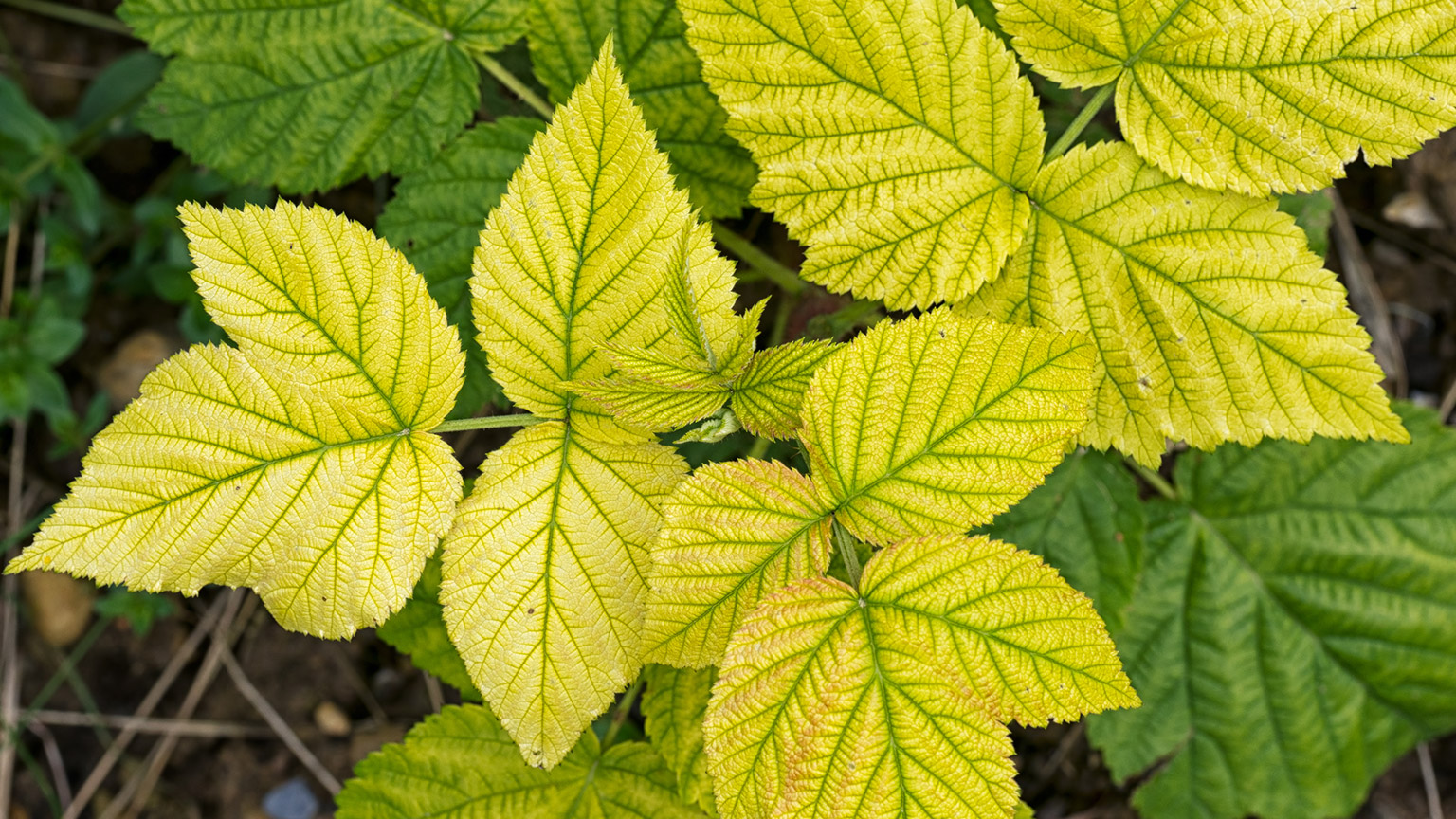The yellowing leaves and green veins of this raspberry (Rubus idaeus) may indicate a nutrient deficiency.
Previously, we described what healthy plants look like. In this topic we’ll review this and turn our attention to plant disorders: abnormal conditions that affect a plant's growth, development, or functioning.
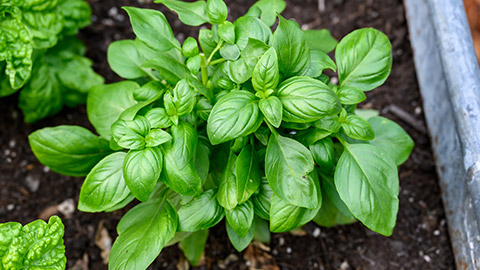
Basil (Ocimum basilicum) is a terrific companion plant to tomatoes. And they taste great together.
Let's recap what we know about healthy plants. Use this activity to challenge yourself. Be sure to check the solution before moving on to ensure you clearly understand what a healthy plant looks like.
*Compartmentalisation happens when a tree responds to wounds by forming natural barriers, which reduces the risk of toxic pathogens entering the plant.
But what are plant disorders? Let’s find out.
Plant disorders are things that negatively impact plant health but aren’t caused by pests or diseases. In this subtopic we’ll look at five common disorders.
Frost damage
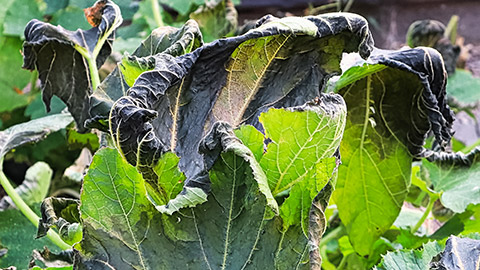
This courgette (Cucurbita pepo) has been impacted by a frost.
Frost can cause significant damage to plants, especially delicate and vulnerable new growth and flowers during the spring season.
Signs of frost damage include:
- Tender young growth may be damaged by spring frosts, causing scorching and pale brown patches to appear between the leaf veins. This tends to be on the exposed and top edges of the plant.
- Hard frost in winter can cause the leaves of hardy evergreen plants to be scorched and turn brown, and may eventually lead to the death of the plant.
- The foliage of tender perennials e.g. dahlia and canna may be blackened by the first frost of autumn. Stems usually collapse.
- Spring frosts can damage blossom and young fruits. This may cause a corky layer to form at the flower end of the fruit i.e. apple and damage to blossom may lead to few or no fruits forming.
The best ways to avoid first damage are:
- When selecting plants for your garden, choose varieties that are frost hardy and can withstand cold temperatures.
- Always harden off plants before planting outside. Hardening off is the process of helping plants that were started indoors (or a greenhouse or cold frame) to become accustomed to cooler temperatures before moving them outdoors.
- Plant in sheltered locations, such as near a wall or fence.
- If possible, move potted plants indoors or to a protected area, such as a greenhouse or covered porch, during cold nights to prevent frost damage.
- Cover plants with a double layer of horticultural fleece or other suitable protection when frost is forecast and remove afterwards.
- Apply a layer of mulch around the base of plants at the beginning of the frost season to insulate the soil and prevent frost from penetrating the roots.
Back to list
Nutrient deficiency
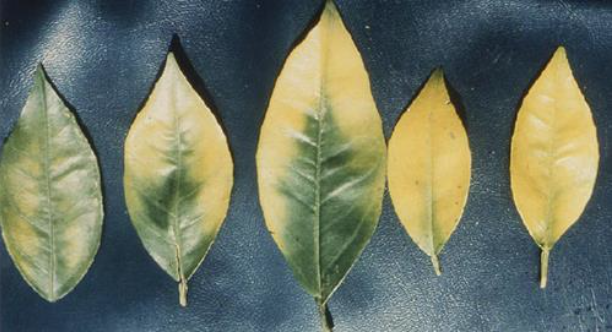
According to Yara.co.nz, this lemon (Citrus limon) is likely to have a magnesium deficiency.
Source: Yara.co.nz
RHS GardeningIf plants fail to thrive, despite adequate soil preparation, watering and mulching, it may be a sign of a nutrient deficiency.
A nutrient deficiency occurs when a plant is unable to obtain a sufficient amount of a particular nutrient from its environment to meet its metabolic needs. There are various essential nutrients that plants require to grow and develop properly, including macronutrients such as nitrogen, phosphorus, and potassium, as well as micronutrients such as iron, zinc, and manganese.
When a plant is deficient in a particular nutrient, it can exhibit a range of symptoms depending on the nutrient in question. Yellow or reddish-coloured leaves, stunted growth and poor flowering are all common symptoms of nitrogen, magnesium or potassium deficiency.
This page, Nutrient Deficiencies, from RHS Gardening provides a useful summary of several of the most common nutrient deficiencies, how to identify them and how to remedy them.
Oedema
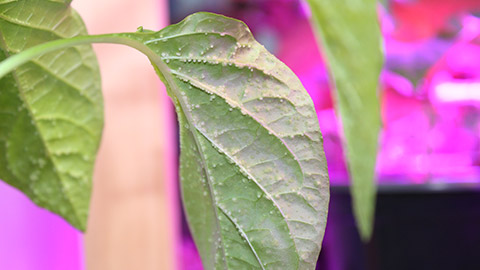
The small bumps on the underside of this pepper (Capsicum spp.) leaf look like oedema (edema).
Oedema is the development of blisters or bumps on the leaves or stems that occurs when the roots take up water faster than the leaves can transpire. These eventually rupture (burst) leading to discoloration and scarring on the plant.
Oedema can be brought on by overwatering (by irrigation or heavy rain) or high humidity.
The signs oedema in plants are:
- Water-soaked spots appear first on the leaves. These then become raised, warty or pimple-like swellings or growths.
- The growths can rupture and have a white, powdery appearance or may become rust-coloured and appear as scaly patches. These can sometimes be confused with other disorders or diseases, such as fuchsia rust.
- Corky spots or ridges may develop, particularly on woody plants such as camellias.
Don’t remove the leaves of plants that have suffered from oedema, as this will further reduce the plant’s ability to transpire. Likewise, don’t prune the plants until the problem has been resolved. Check the soil to see if it is sodden/waterlogged. If so, and if this is a recurring problem, aerate the soil, add compost, or install drainage.
Overwatering
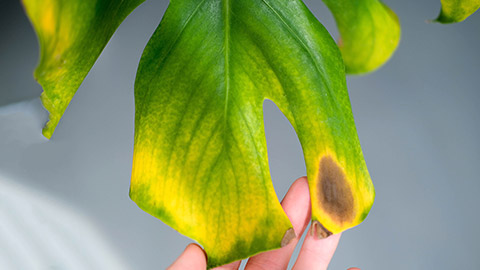
This monstera (Monstera spp.) has been overwatered. The yellowing of the older leaves is a sign of this problem.
Overwatering is a common plant problem particularly in heavy or poorly draining soils. The cause of the overwatering can be from frequent heavy rain or from over irrigating the plants. When there is too much water in the soil, air is pushed out of the pore spaces and the plant roots don’t have access to the oxygen they need to work properly, such as for cellular respiration.
Signs of overwatering include:
- Plant growth slows down (we call this a loss of vigour).
- Both young and old leaves become yellow.
- Oedema may appear on stems and leaves.
- Plants may suffer from leaf burn, which presents as:
...browning of plant tissues, including leaf margins and tips, and yellowing or darkening of veins.
Water stress
Source: Redding.com
Water stress occurs when plants don’t have enough water. Water is critical for many core plant processes, such as transpiration, translocation, and photosynthesis.
Let's refresh our memory of what transpiration means with this short activity.
Signs of water stress include:
- Leaves may change from being glossy to dull.
- Plants wilt or stops growing.
- Crop production reduces.
- Leaves, flowers, and buds become discoloured.
- Bare patches appear in surrounding grass and ground cover plants.
If you’re not sure if a plant is suffering from overwatering or water stress, feel the soil. Dig down deeper into the root zone and touch the soil. Does it feel dry, moist, or sodden?
If it’s dry, it's a good time to water the soil deeply. If it’s sodden, don’t water. Consider aerating your soil, adding compost, or installing drainage.
If it’s moist, the problem may not be related to water.
Activity – Identify the plant problem
Imagine that you have been asked to diagnose plant problems by the people in your life that know you can help them! See if you can select the correct problem using your friend's description. Each has only one answer and the questions will progress automatically.
Whakamihi! Congratulations you have completed the learning for Module 6 of Horticulture Level 3.
